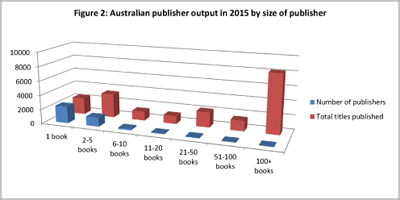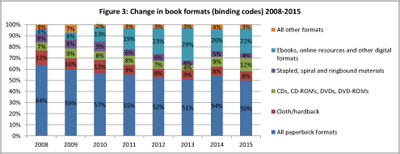The market down under
Book sales edged up in Australia for the second year in a row as the market continues its recovery after several years of decline. Brad Jefferies presents an overview of the Australian book industry.
The Australian retail book market posted marginal growth in 2015, making it the second year in a row that sales have grown by single-digit figures after a period of decline. Sales were up 2.4% in value and 0% in volume, boosted in no small part by sales of adult colouring books.
Standing out among the local bestsellers once again was Andy Griffiths and Terry Denton’s ‘Treehouse’ children’s books series. The series sold more than 700,000 copies in the past year (July 2015 to June 2016), led by The 65-Storey Treehouse, which alone sold 347,000 copies. It was far ahead of the bestselling Australian adult fiction book, Rosalie Ham’s 2000 novel The Dressmaker (Duffy & Snellgrove), which sold 131,000 copies on the back of the film adaptation’s release.
Sales tracking service Nielsen Book reports the total turnover of the Australian print book market in 2015 was A$979m (56.4m books), up from A$938m (55.5m books) in 2014. Although the book market peaked at A$1.3b in 2010, after two years of successive growth it’s continuing to edge away from its low of $917m in 2013. It’s also worth noting these figures do not include ebooks and audiobooks, as their sales in Australia aren’t tracked in any reliable way.
Ebook sales are estimated to comprise around 20% of the market with the prevailing view that this has plateaued for the time being. Notably, Pan Macmillan Australia’s digital-only imprint, Momentum, was dramatically scaled down and folded back into the publisher earlier this year. The two biggest audiobook providers, Bolinda and Audible, have reported triple and quadruple jumps in revenue respectively over the past several years, albeit from low bases.
The media has jumped on the narrative of the recovering market, with stories about the resilience of bookshops replacing those bemoaning the death of print several years ago. Several prominent independent bookstores in Sydney and Melbourne have opened or announced plans to open new stores over the past 12 months, contributing to the sense of revival, while the largest chain has reported its fourth straight year of growth. Indie bookstores represent just over 26% of the print book market in Australia; chain and online-only stores represent around 44%; and discount department stores are taking an increasingly larger proportion of sales, accounting for 29.8% of the market, up 4.4% on 2014.

Book numbers fall, digital format remains steady
In 2015, 3996 different publishing entities in Australia produced 19,971 new titles, according to figures extracted from ISBN records added to Bowker’s Books in Print. This is down from 2013, when the number of new titles peaked at 28,234, and marginally down from 2014, which saw 20,877 titles published.
At the big end, 27 companies published over 100 titles during 2015, down from 33 companies in 2013 but up from 24 companies in 2014. Below the big publishers is a middle-ground, where 90 publishers produced between 20 and 99 titles each, and 78 published between 11 and 20 titles. At the other end of the scale, 2350 publishers only released one title in the year. Many of these are likely to be self-publishers.
When it comes to formats, print continues to dominate the market. Paperback titles made up half of all sales in 2015, falling from 54% in 2014. Digital made up 22%, up from 20% in 2014 but down from the market high of 29% in 2013. It is possible that there was a spike in 2013 as a number of publishers began to release ebook editions of their backlist titles.
According to Nielsen Book, 46% of books bought by Australian readers in 2015 were nonfiction, 24% were fiction and 30% were children’s.

Politics and legislation
The government looks set to throw open the doors of the Australian bookselling market to the global economy with plans to repeal the protectionist parallel import restrictions (PIRs) on books, which have been enshrined in Australia’s copyright laws since the early 1990s. The current rule gives Australian publishers 30 days from overseas publication to establish their copyright by making it available in Australia, with publishers prohibited from importing titles for sale during this time.
The debate has consumed the major industry bodies since April, when the Productivity Commission—the government’s economic advisory body—recommended the abolition of PIRs in a draft report reviewing Australia’s intellectual property. The issue, however, is not a new one: in 2009 the then-government also received a recommendation to repeal PIRs from the Productivity Commission but ultimately decided to keep PIRs in place.
The major industry bodies, including the Australian publishing, bookselling and authors associations, copyright body and printing industry groups, have united to lobby the government against the proposed change, as well as the recommendation to introduce a US-style fair use provision to its copyright law.

International appeal
Australian publishers continue to produce books with international appeal, with many titles finding rights and translation deals in diverse territories long after their initial domestic publication. We round-up some of these rights sales highlights on page 8. Also turn to page 18 for our annual survey of the Australian rights scene.
Australia’s Frankfurt HQ
This year the hub for Australian exhibitors at the Frankfurt Book Fair will be the Australian Publishers Association (APA) stand at Hall 6.2, Stand A62 [CHECK]—although many Australians will also be found on the stands of global parent companies, in the Rights Centre or ‘wandering the halls’ from appointment to appointment. To let your hair down, loosen your tie and experience Aussies in party mode, the annual Australian party will be held from 5pm on the Thursday of the fair, with the APA stand doubling as a bar serving Australian beer and wine.
Australia at a glance
- Population: 24.2 million (Aug 2016)
- Number of books published annually: 19,971 (Australian ISBN records for 2015, including educational titles, Australian editions of overseas-originated titles, and multiple formats of the same title)
- Number of Australian publishers: 3996 (2355 of which only published one title last year)
- Total number of active publishers: 371 (published more than five titles last year)
- Book retail outlets: Over 1000
- Retail sales of books in 2015: A$979 (56.4m books)
- Sources: Australian Bureau of Statistics, Thorpe-Bowker, Nielsen BookScan, Australian Booksellers Association
- Currency conversion: At the time of writing, one Australian dollar is worth approximately 0.68, US$0.76 and £0.58.
See the Australian book industry first-hand
Australia’s book culture is buzzing. Every major city and many regional centres have annual writers’ festivals that attract audiences of many thousands of keen readers. The Australia Council organises the Visiting International Publishers program, which brings publishing and rights professionals from around the world to either the Sydney Writers’ Festival or Adelaide Writers’ Week (see www.australiacouncil.gov.au). The publishing industry will also gather in Melbourne from 9-12 November for the fifth annual Independent Publishing Conference (see smallpressnetwork.com.au).
This article was first published in Think Australian 2016.
Category: Features Think Aus magazine





